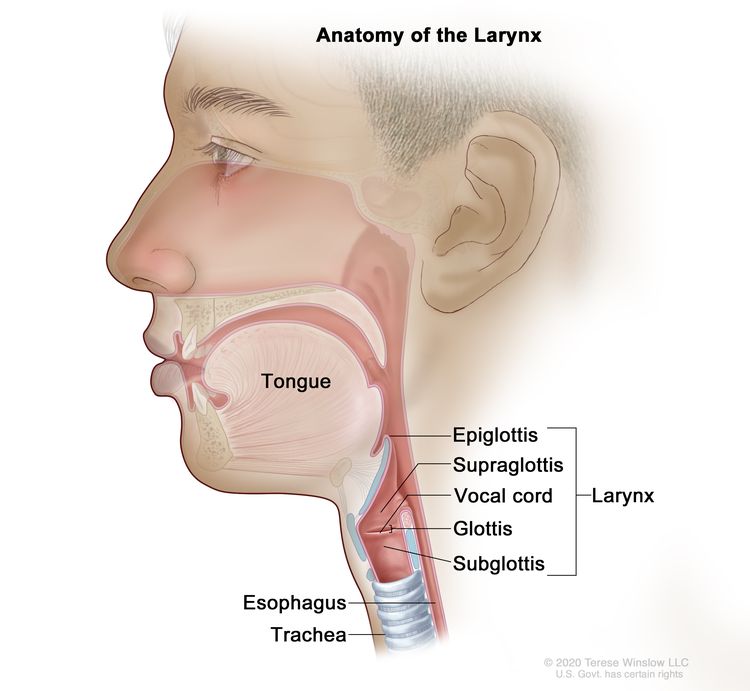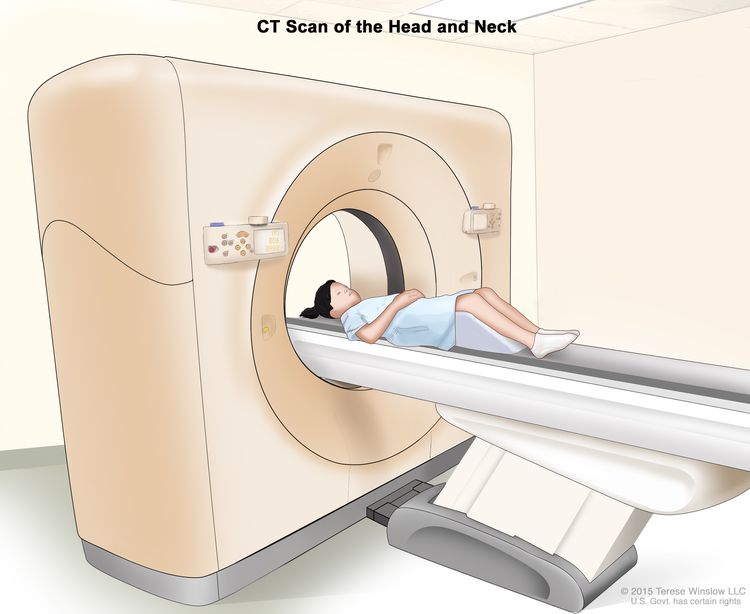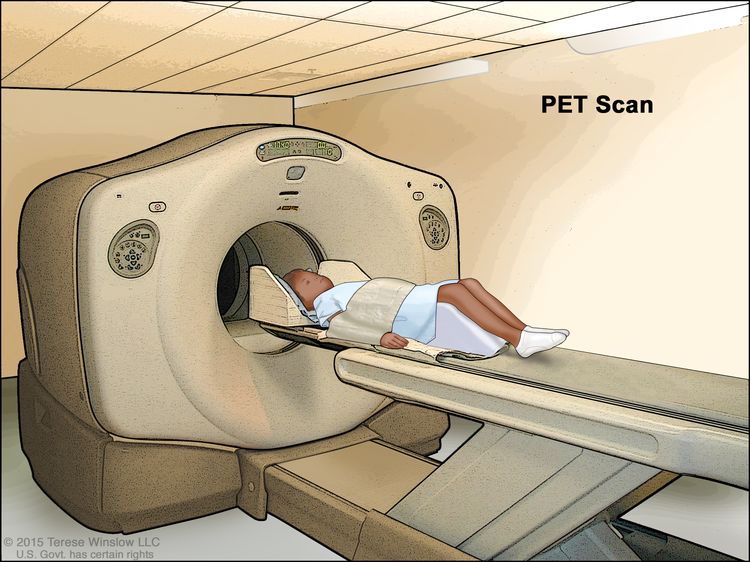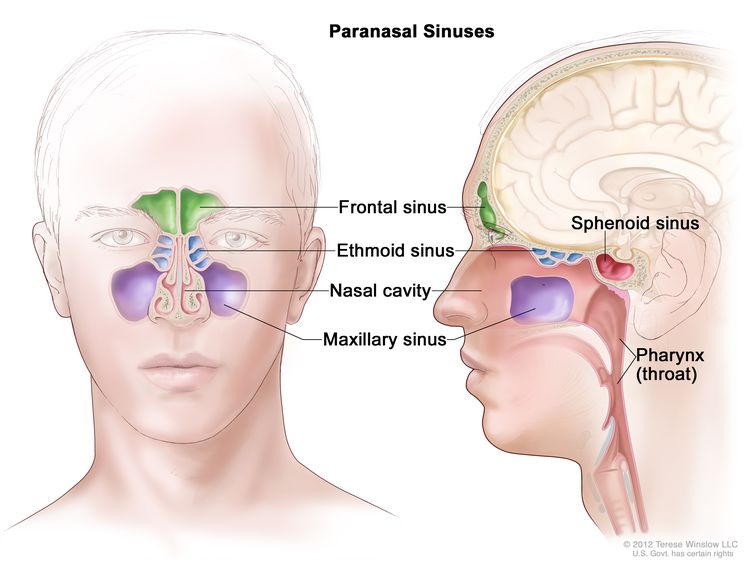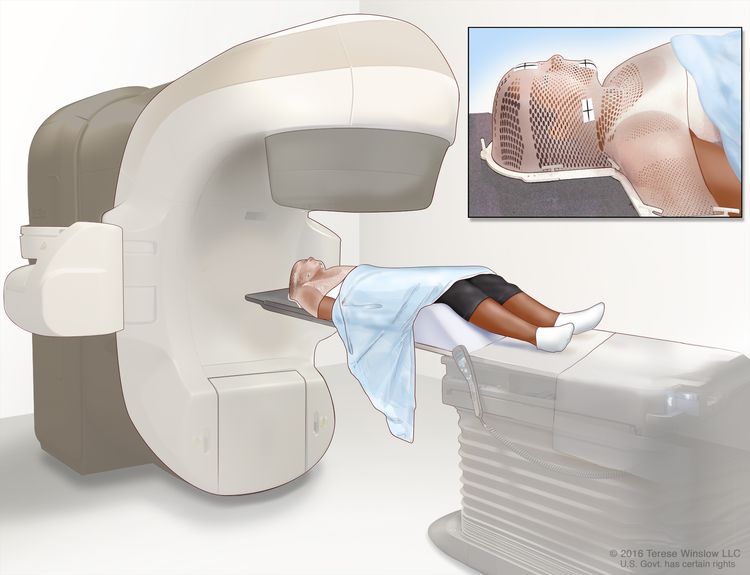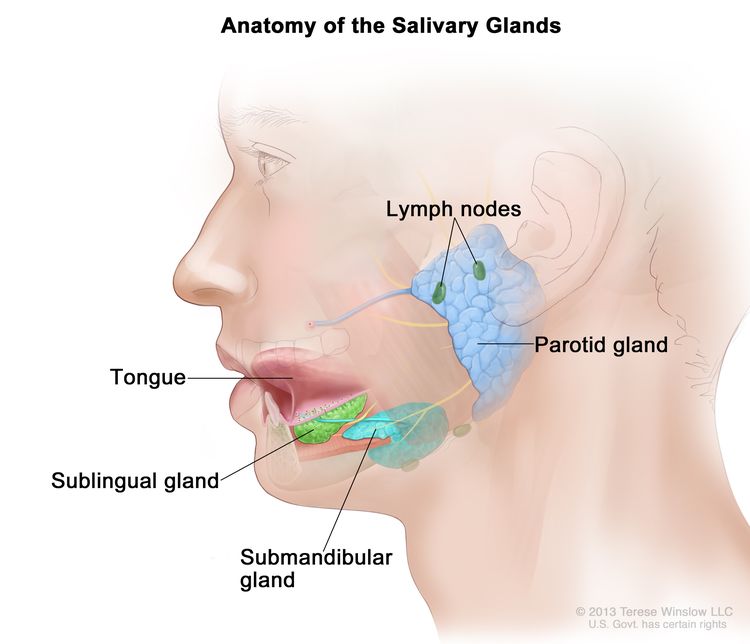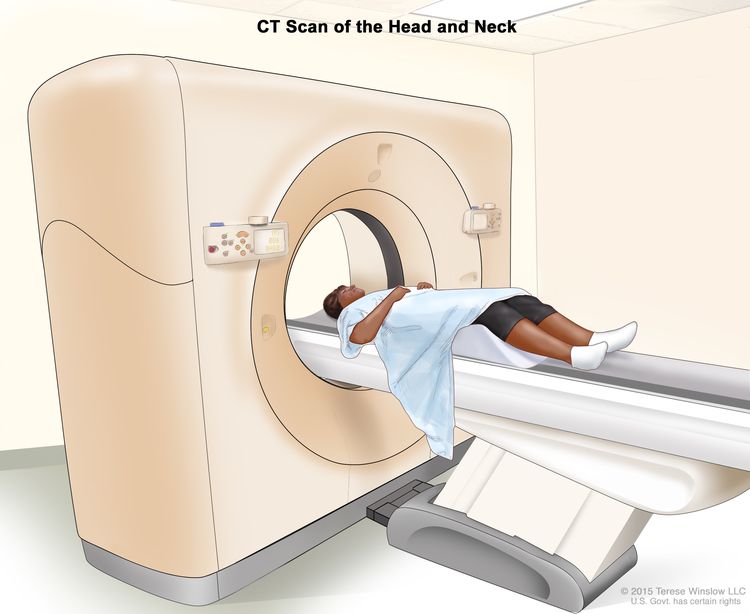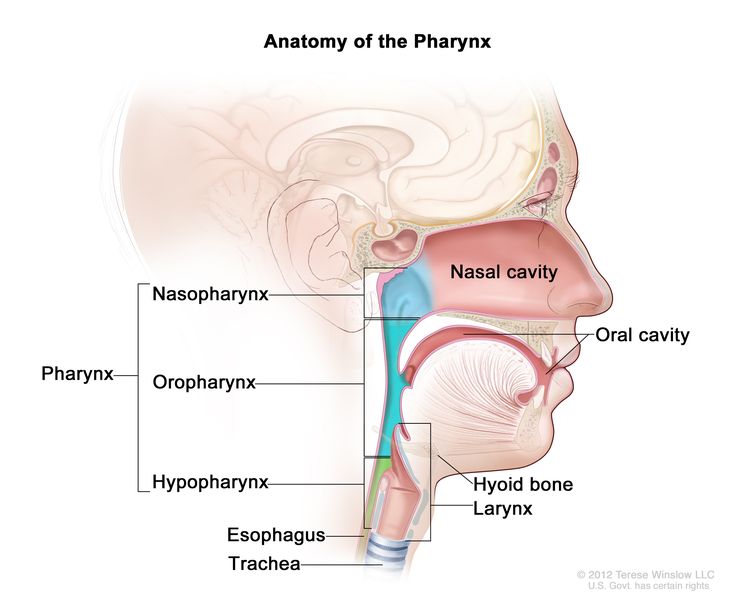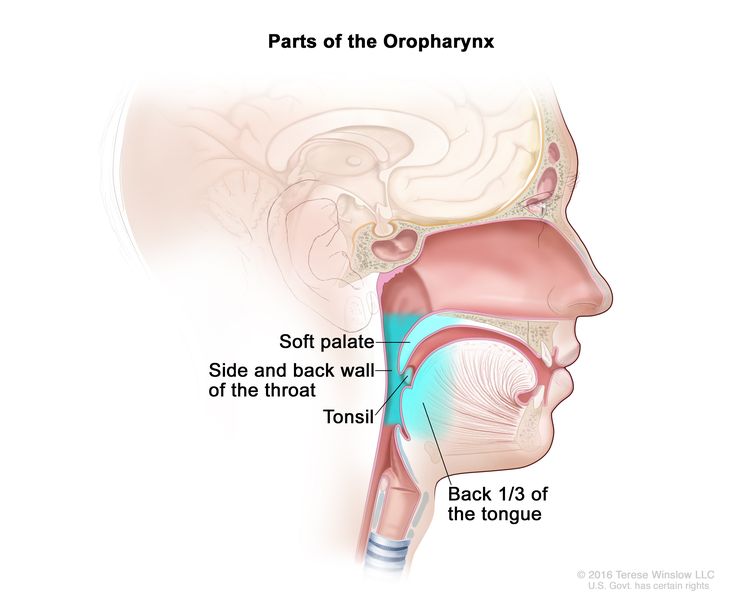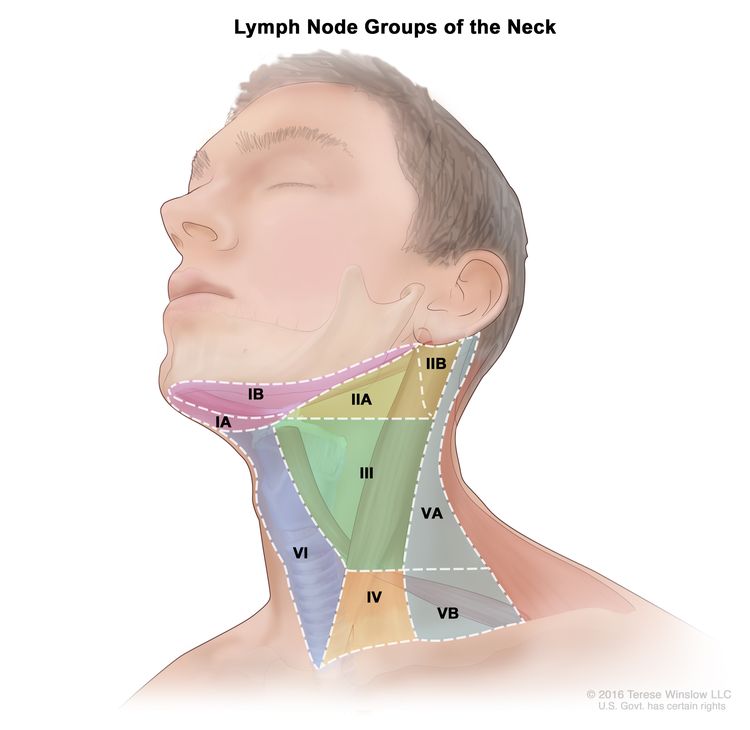Childhood Nasopharyngeal Cancer (PDQ®)–Patient Version
What is childhood nasopharyngeal cancer?
Childhood nasopharyngeal cancer is a rare type of cancer that forms in the tissue lining the nasopharynx. The nasopharynx is the upper part of the throat behind the nose. The nostrils allow air into the nasopharynx. Air and food pass through the pharynx on the way to the trachea or esophagus.
Nasopharyngeal cancer is more common in children aged 10 to 19 years than in children younger than 10 years.

Causes and risk factors for childhood nasopharyngeal cancer
Childhood nasopharyngeal cancer is caused by certain changes in the way the cells in the nasal cavity and top part of the throat function, especially how they grow and divide into new cells. Often, the exact cause of these changes is unknown. Learn more about how cancer develops at What Is Cancer?
A risk factor is anything that increases the chance of getting a disease. A known risk factor for childhood nasopharyngeal cancer is infection from the Epstein-Barr virus (EBV). Not every child with this risk factor will develop nasopharyngeal cancer. And it will develop in some children who don’t have a known risk factor. Talk with your child’s doctor if you think your child may be at risk.
Symptoms of childhood nasopharyngeal cancer
Children may not have symptoms of nasopharyngeal cancer until the tumor has grown bigger. It’s important to check with your child’s doctor if your child has:
- a headache
- a blocked or stuffy nose
- nosebleeds
- an earache
- an ear infection
- hearing loss
- problems moving the jaw
- trouble speaking
- trouble seeing or a droopy eyelid
- lumps in the neck that may be painful
These symptoms may be caused by problems other than nasopharyngeal cancer. The only way to know is for your child to see a doctor.
Tests to diagnose childhood nasopharyngeal cancer
If your child has symptoms that suggest nasopharyngeal cancer, the doctor will need to find out if these are due to cancer or another problem. The doctor will ask when the symptoms started and how often your child has been having them. They will also ask about your child’s personal and family medical history and do a physical exam. Depending on these results, the doctor may recommend other tests. If your child is diagnosed with nasopharyngeal cancer, the results of these tests will help plan treatment.
Diagnostic tests
The tests used to diagnose nasopharyngeal cancer may include:
Magnetic resonance imaging (MRI)
MRI uses a magnet, radio waves, and a computer to make a series of detailed pictures of areas of the body, such as the head and neck. This procedure is also called nuclear magnetic resonance imaging (NMRI).
Nasal endoscopy
Nasal endoscopy is a procedure to look at organs and tissues inside the body to check for abnormal areas. A flexible or rigid endoscope is inserted through the nose. An endoscope is a thin, tube-like instrument with a light and a lens for viewing. It may also have a tool to remove tissue samples, which are checked under a microscope by a pathologist for signs of disease.
Epstein-Barr virus (EBV) tests
Epstein-Barr virus (EBV) tests use a sample of blood to check for antibodies to the Epstein-Barr virus and DNA markers of the Epstein-Barr virus. These are found in the blood of patients who have been infected with EBV.
Tests to stage nasopharyngeal cancer
If your child is diagnosed with nasopharyngeal cancer, they will be referred to a pediatric oncologist. This is a doctor who specializes in staging and treating nasopharyngeal cancer and other cancers. They will recommend tests to determine the extent (stage) of cancer. Sometimes the cancer is only in the nasopharynx. Or, it may have spread to other parts of the body. The process of learning the extent of cancer in the body is called staging. It is important to know the stage of the nasopharyngeal cancer in order to plan the best treatment.
Most children with nasopharyngeal cancer are at an advanced stage at the time of diagnosis. Nasopharyngeal cancer spreads most often to the bone, lung, and liver.
For information about a specific stage of nasopharyngeal cancer, see Childhood Nasopharyngeal Cancer Stages.
The following procedures may be used to determine the nasopharyngeal cancer stage:
Neurological exam
A neurologic exam is a series of questions and tests done to check the brain, spinal cord, and nerve function. The exam checks a person’s mental status, coordination, and ability to walk normally, and how well the muscles, senses, and reflexes work. This may also be called a neuro exam.
Chest x-ray
Chest x-ray is a type of radiation that can go through the body and make pictures of the organs and bones inside the chest.
PET-CT scan
PET-CT scan combines the pictures from a positron emission tomography (PET) scan and a computed tomography (CT) scan. The PET and CT scans are done at the same time on the same machine. The combined scans make more detailed pictures than either test would make by itself.
- For the PET scan, a small amount of radioactive sugar (also called radioactive glucose) is injected into a vein. The PET scanner rotates around the body and makes a picture of where sugar is being used in the body. Cancer cells show up brighter in the picture because they are more active and take up more sugar than normal cells do.
- For the CT scan (CAT scan), a computer linked to an x-ray machine makes a series of detailed pictures of areas inside the body. The pictures are taken from different angles and are used to create 3-D views of tissues and organs. A dye may be injected into a vein or swallowed to help the organs or tissues show up more clearly. Often, a chest CT scan is done. This procedure is also called computed tomography, computerized tomography, or computerized axial tomography. Learn more about Computed Tomography (CT) Scans and Cancer.
Getting a second opinion
You may want to get a second opinion to confirm your child’s cancer diagnosis and treatment plan. If you seek a second opinion, you will need to get medical test results and reports from the first doctor to share with the second doctor. The second doctor will review the pathology report, slides, and scans. This doctor may agree with the first doctor, suggest changes to the treatment plan, or provide more information about your child’s cancer.
To learn more about choosing a doctor and getting a second opinion, visit Finding Cancer Care. You can contact NCI’s Cancer Information Service via chat, email, or phone (both in English and Spanish) for help finding a doctor or hospital that can provide a second opinion. For questions you might want to ask at your child’s appointments, visit Questions to Ask Your Doctor about Cancer.
Stages of childhood nasopharyngeal cancer
The cancer stage describes the extent of cancer in the body, such as the size of the tumor, whether it has spread, and how far it has spread from where it first formed. It is important to know the stage of nasopharyngeal cancer to plan the best treatment.
There are several staging systems for cancer. Nasopharyngeal cancer staging usually uses the TNM staging system. You may see your child’s cancer described by this staging system in the pathology report. Based on the TNM results, a stage (I, II, III, or IV, also written as 1, 2, 3, or 4) is assigned to your child’s cancer. When talking with you about your child’s cancer, your child’s doctor may describe it as one of these stages.
Learn more about Cancer Staging.
Learn about the tests and procedures used to determine the stage of nasopharyngeal cancer.
Stage 0 nasopharyngeal cancer
In stage 0, abnormal cells are found in the lining of the nasopharynx. These abnormal cells may become cancer and spread into nearby normal tissue. Stage 0 is also called carcinoma in situ.
Stage I nasopharyngeal cancer
In stage I, nasopharyngeal cancer has formed and is found in the nasopharynx only or has spread from the nasopharynx to the oropharynx and/or nasal cavity.
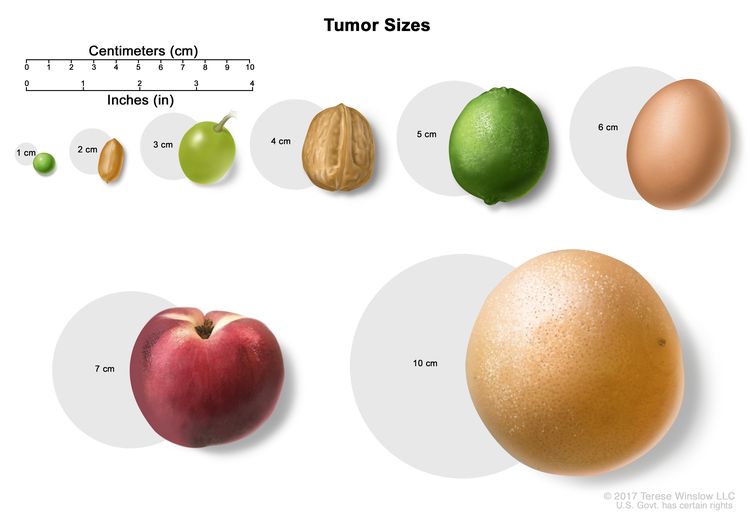
Stage II nasopharyngeal cancer
Stage II is based on the location of the cancer and whether it has spread. A child may have one of the following:
- Cancer has spread to one or more lymph nodes on one side of the neck and/or to one or more lymph nodes on one or both sides of the back of the throat. The affected lymph nodes are 6 centimeters or smaller. Cancer is found:
- in the nasopharynx only or has spread from the nasopharynx to the oropharynx and/or to the nasal cavity; or
- only in the lymph nodes in the neck. The cancer cells in the lymph nodes are infected with Epstein-Barr virus (a virus linked to nasopharyngeal cancer). Cancer was not found in the nasopharynx.
- Cancer has spread to the parapharyngeal space and/or nearby muscles. Cancer may have also spread to one or more lymph nodes on one side of the neck and/or to one or more lymph nodes on one or both sides of the back of the throat. The affected lymph nodes are 6 centimeters or smaller.
Stage III nasopharyngeal cancer
Stage III is based on the location of the cancer and whether it has spread. A child may have one of the following:
- Cancer has spread to one or more lymph nodes on both sides of the neck. The affected lymph nodes are 6 centimeters or smaller. Cancer is found:
- in the nasopharynx only or has spread from the nasopharynx to the oropharynx and/or to the nasal cavity; or
- only in the lymph nodes in the neck. The cancer cells in the lymph nodes are infected with Epstein-Barr virus (a virus linked to nasopharyngeal cancer). Cancer was not found in the nasopharynx.
- Cancer has spread to the parapharyngeal space and/or nearby muscles. Cancer has also spread to one or more lymph nodes on both sides of the neck. The affected lymph nodes are 6 centimeters or smaller.
- Cancer has spread to the bones at the bottom of the skull, the bones in the neck, jaw muscles, and/or the sinuses around the nose and eyes. Cancer may have also spread to one or more lymph nodes on one or both sides of the neck and/or the back of the throat. The affected lymph nodes are 6 centimeters or smaller.
Stage IV nasopharyngeal cancer
Stage IV is subdivided based on whether the cancer has spread to other tissue.
- In stage IVA:
- Cancer has spread to the brain, the cranial nerves, the hypopharynx, the salivary gland in front of the ear, the bone around the eye, and/or the soft tissues of the jaw. Cancer may have also spread to one or more lymph nodes on one or both sides of the neck and/or the back of the throat. The affected lymph nodes are 6 centimeters or smaller; or
- Cancer has spread to one or more lymph nodes on one or both sides of the neck. The affected lymph nodes are larger than 6 centimeters and/or are found in the lowest part of the neck.
- In stage IVB: Cancer has spread beyond the lymph nodes in the neck to distant lymph nodes, such as those between the lungs, below the collarbone, or in the armpit or groin, or to other parts of the body, such as the lung, bone, or liver.
Stage IV nasopharyngeal cancer is also called metastatic nasopharyngeal cancer. Metastatic cancer happens when cancer cells travel through the lymphatic system or blood and form tumors in other parts of the body. The metastatic tumor is the same type of cancer as the primary tumor. For example, if nasopharyngeal cancer spreads to the lung, the cancer cells in the lung are actually nasopharyngeal cancer cells. The disease is called metastatic nasopharyngeal cancer, not lung cancer. Learn more in Metastatic Cancer: When Cancer Spreads.
Recurrent nasopharyngeal cancer
Recurrent nasopharyngeal cancer is cancer that has come back after it has been treated. Nasopharyngeal cancer may come back in the nasopharynx, or in other parts of the body, such as the bone, lung, or liver. Tests will be done to help determine where the cancer has returned in the body, if it has spread, and how far. The type of treatment that your child will have for recurrent nasopharyngeal cancer will depend on where it has come back.
Learn more in Recurrent Cancer: When Cancer Comes Back.
Types of treatment for childhood nasopharyngeal cancer
Who treats children with nasopharyngeal cancer?
A pediatric oncologist, a doctor who specializes in treating children with cancer, oversees treatment of nasopharyngeal cancer. The pediatric oncologist works with other health care providers who are experts in treating children with cancer and who specialize in certain areas of medicine. Other specialists may include:
Treatment options
There are different types of treatment for children and adolescents with nasopharyngeal cancer. You and your child’s care team will work together to decide treatment. Many factors will be considered, such as your child’s overall health and whether the cancer is newly diagnosed or has come back.
Your child’s treatment plan will include information about the cancer, the goals of treatment, treatment options, and the possible side effects. It will be helpful to talk with your child’s care team before treatment begins about what to expect. For help every step of the way, visit our booklet, Children with Cancer: A Guide for Parents.
The types of treatment your child might have include:
Chemotherapy
Chemotherapy (also called chemo) uses drugs to stop the growth of cancer cells. Chemotherapy either kills the cancer cells or stops them from dividing. Chemotherapy may be given alone or with other types of treatment, such as radiation therapy.
Chemotherapy for nasopharyngeal cancer is injected into a vein. When given this way, the drugs enter the bloodstream to reach cancer cells throughout the body. Chemotherapy used alone or in combination to treat nasopharyngeal cancer in children include:
Other chemotherapy not listed here may also be used.
Learn more about how chemotherapy works, how it is given, common side effects, and more at Chemotherapy to Treat Cancer.
Radiation therapy
Radiation therapy uses high-energy x-rays or other types of radiation to kill cancer cells or keep them from growing. Nasopharyngeal cancer is treated with external beam radiation therapy. This type of radiation therapy uses a machine outside the body to send radiation toward the area of the body with cancer. Radiation therapy may be given alone or with other treatments, such as chemotherapy.
Learn more about External Beam Radiation Therapy for Cancer and Radiation Therapy Side Effects.
Surgery
Surgery to remove the tumor is done if the tumor has not spread throughout the nasal cavity and throat at the time of diagnosis.
Immunotherapy
Immunotherapy uses a person’s immune system to fight cancer. Interferon may be used to treat nasopharyngeal cancer.
Learn more about Immunotherapy to Treat Cancer.
Clinical trials
For some children, joining a clinical trial may be an option. There are different types of clinical trials for childhood cancer. For example, a treatment trial tests new treatments or new ways of using current treatments. Supportive care and palliative care trials look at ways to improve quality of life, especially for those who have side effects from cancer and its treatment.
You can use the clinical trial search to find NCI-supported cancer clinical trials accepting participants. The search allows you to filter trials based on the type of cancer, your child’s age, and where the trials are being done. Clinical trials supported by other organizations can be found on the ClinicalTrials.gov website.
Learn more about clinical trials, including how to find and join one, at Clinical Trials Information for Patients and Caregivers.
Treatment of childhood nasopharyngeal cancer
Treatment of newly diagnosed nasopharyngeal cancer in children may include:
- Chemotherapy followed by chemotherapy and radiation therapy given at the same time. Interferon may also be given.
- Surgery to remove the tumor.
Treatment of refractory or recurrent nasopharyngeal cancer is chemotherapy.
Use our clinical trial search to find NCI-supported cancer clinical trials that are accepting patients. You can search for trials based on the type of cancer, the age of the patient, and where the trials are being done. General information about clinical trials is also available.
Prognostic factors for childhood nasopharyngeal cancer
If your child has been diagnosed with nasopharyngeal cancer, you likely have questions about how serious the cancer is and your child’s chances of survival. The likely outcome or course of a disease is called prognosis. The prognosis can be affected by whether the cancer has spread to other parts of the body at the time of diagnosis and whether the cancer has just been diagnosed or has recurred (come back). No two people are alike, and responses to treatment can vary greatly. Your child’s cancer care team is in the best position to talk with you about your child’s prognosis.
Side effects and late effects of treatment
Cancer treatments can cause side effects. Which side effects your child might have depends on the type of treatment they receive, the dose, and how their body reacts. Talk with your child’s treatment team about which side effects to look for and ways to manage them.
To learn more about side effects that begin during treatment for cancer, visit Side Effects.
Problems from cancer treatment that begin 6 months or later after treatment and continue for months or years are called late effects. Late effects of cancer treatment may include:
- problems with the thyroid gland
- decreased mouth function
- hearing loss or chronic ear infections
- dental cavities
- chronic sinusitis
- changes in mood, feelings, thinking, learning, or memory
- second cancers (new types of cancer) or other problems
Some late effects may be treated or controlled. It is important to talk with your child’s doctors about the possible late effects caused by some treatments. Learn more about Late Effects of Treatment for Childhood Cancer.
Follow-up care
As your child goes through treatment, they will have follow-up tests or check-ups. Some tests that were done to diagnose or stage the cancer may be repeated to see how well the treatment is working. Decisions about whether to continue, change, or stop treatment may be based on the results of these tests.
Some of the tests will continue to be done from time to time after treatment has ended. The results of these tests can show if your child’s condition has changed or if the cancer has recurred (come back).
Coping with your child's cancer
When your child has cancer, every member of the family needs support. Taking care of yourself during this difficult time is important. Reach out to your child’s treatment team and to people in your family and community for support. To learn more, visit Support for Families: Childhood Cancer and the booklet Children with Cancer: A Guide for Parents.
Related Resources
For more childhood cancer information and other general cancer resources, visit:
About This PDQ Summary
About PDQ
Physician Data Query (PDQ) is the National Cancer Institute’s (NCI’s) comprehensive cancer information database. The PDQ database contains summaries of the latest published information on cancer prevention, detection, genetics, treatment, supportive care, and complementary and alternative medicine. Most summaries come in two versions. The health professional versions have detailed information written in technical language. The patient versions are written in easy-to-understand, nontechnical language. Both versions have cancer information that is accurate and up to date and most versions are also available in Spanish.
PDQ is a service of the NCI. The NCI is part of the National Institutes of Health (NIH). NIH is the federal government’s center of biomedical research. The PDQ summaries are based on an independent review of the medical literature. They are not policy statements of the NCI or the NIH.
Purpose of This Summary
This PDQ cancer information summary has current information about the treatment of childhood nasopharyngeal cancer. It is meant to inform and help patients, families, and caregivers. It does not give formal guidelines or recommendations for making decisions about health care.
Reviewers and Updates
Editorial Boards write the PDQ cancer information summaries and keep them up to date. These Boards are made up of experts in cancer treatment and other specialties related to cancer. The summaries are reviewed regularly and changes are made when there is new information. The date on each summary (“Updated”) is the date of the most recent change.
The information in this patient summary was taken from the health professional version, which is reviewed regularly and updated as needed, by the PDQ Pediatric Treatment Editorial Board.
Clinical Trial Information
A clinical trial is a study to answer a scientific question, such as whether one treatment is better than another. Trials are based on past studies and what has been learned in the laboratory. Each trial answers certain scientific questions in order to find new and better ways to help cancer patients. During treatment clinical trials, information is collected about the effects of a new treatment and how well it works. If a clinical trial shows that a new treatment is better than one currently being used, the new treatment may become “standard.” Patients may want to think about taking part in a clinical trial. Some clinical trials are open only to patients who have not started treatment.
Clinical trials can be found online at NCI’s website. For more information, call the Cancer Information Service (CIS), NCI’s contact center, at 1-800-4-CANCER (1-800-422-6237).
Permission to Use This Summary
PDQ is a registered trademark. The content of PDQ documents can be used freely as text. It cannot be identified as an NCI PDQ cancer information summary unless the whole summary is shown and it is updated regularly. However, a user would be allowed to write a sentence such as “NCI’s PDQ cancer information summary about breast cancer prevention states the risks in the following way: [include excerpt from the summary].”
The best way to cite this PDQ summary is:
PDQ® Pediatric Treatment Editorial Board. PDQ Childhood Nasopharyngeal Cancer. Bethesda, MD: National Cancer Institute. Updated <MM/DD/YYYY>. Available at: /types/head-and-neck/patient/child/nasopharyngeal-treatment-pdq. Accessed <MM/DD/YYYY>.
Images in this summary are used with permission of the author(s), artist, and/or publisher for use in the PDQ summaries only. If you want to use an image from a PDQ summary and you are not using the whole summary, you must get permission from the owner. It cannot be given by the National Cancer Institute. Information about using the images in this summary, along with many other images related to cancer can be found in Visuals Online. Visuals Online is a collection of more than 3,000 scientific images.
Disclaimer
The information in these summaries should not be used to make decisions about insurance reimbursement. More information on insurance coverage is available on Cancer.gov on the Managing Cancer Care page.
Contact Us
More information about contacting us or receiving help with the Cancer.gov website can be found on our Contact Us for Help page. Questions can also be submitted to Cancer.gov through the website’s E-mail Us.

